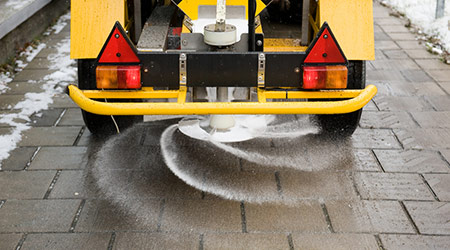One way to cut the amount of salt used is by spreading salt brine before the storm hits, rather than waiting until the snow is on the ground and trying to melt it with rock salt, according to an article from Building Operation Management on the FacilitiesNet website.
The idea is to “get away from de-icing and toward anti-icing,” said Daniel Gilleland, training manager with SnowEx, adding that an application of brine can reduce the amount of chloride needed to melt snow on a parking lot by about 90 percent.
The salt itself doesn’t melt anything; rather, it has to turn to brine in order to work, Gilleland said. “When you apply rock salt, it sits there for some length of time before it turns to brine,” he says. Applying salt as brine accelerates this process.
Moreover, the brine can be applied in advance, as it doesn’t wear off. Instead, it “just dries, and waits for the moisture to come,” Gilleland said. Many departments of transportation apply brine to bridges and steep inclines ahead of storms, to head off slipperiness.
Michigan State University, for instance, uses a liquid de-icer derived from beet juice to melt snow on roads and walkways. According to the university, “the organic de-icer is also more effective under colder weather conditions than traditional salt because it melts the snow and ice at lower temperatures.”

 Building Sustainable Healthcare for an Aging Population
Building Sustainable Healthcare for an Aging Population Froedtert ThedaCare Announces Opening of ThedaCare Medical Center-Oshkosh
Froedtert ThedaCare Announces Opening of ThedaCare Medical Center-Oshkosh Touchmark Acquires The Hacienda at Georgetown Senior Living Facility
Touchmark Acquires The Hacienda at Georgetown Senior Living Facility Contaminants Under Foot: A Closer Look at Patient Room Floors
Contaminants Under Foot: A Closer Look at Patient Room Floors Power Outages Largely Driven by Extreme Weather Events
Power Outages Largely Driven by Extreme Weather Events